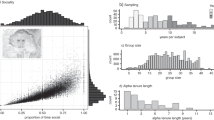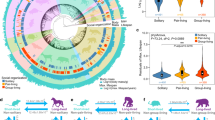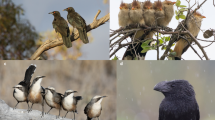Abstract
Although much attention has been focused on explaining and describing the diversity of social grouping patterns among primates1,2,3, less effort has been devoted to understanding the evolutionary history of social living4. This is partly because social behaviours do not fossilize, making it difficult to infer changes over evolutionary time. However, primate social behaviour shows strong evidence for phylogenetic inertia, permitting the use of Bayesian comparative methods to infer changes in social behaviour through time, thereby allowing us to evaluate alternative models of social evolution. Here we present a model of primate social evolution, whereby sociality progresses from solitary foraging individuals directly to large multi-male/multi-female aggregations (approximately 52 million years (Myr) ago), with pair-living (approximately 16 Myr ago) or single-male harem systems (approximately 16 Myr ago) derivative from this second stage. This model fits the data significantly better than the two widely accepted alternatives (an unstructured model implied by the socioecological hypothesis or a model that allows linear stepwise changes in social complexity through time). We also find strong support for the co-evolution of social living with a change from nocturnal to diurnal activity patterns, but not with sex-biased dispersal. This supports suggestions that social living may arise because of increased predation risk associated with diurnal activity. Sociality based on loose aggregation is followed by a second shift to stable or bonded groups. This structuring facilitates the evolution of cooperative behaviours5 and may provide the scaffold for other distinctive anthropoid traits including coalition formation, cooperative resource defence and large brains.
This is a preview of subscription content, access via your institution
Access options
Subscribe to this journal
Receive 51 print issues and online access
$199.00 per year
only $3.90 per issue
Buy this article
- Purchase on Springer Link
- Instant access to full article PDF
Prices may be subject to local taxes which are calculated during checkout




Similar content being viewed by others
References
van Schaik, C. P. Why are diurnal primates living in groups? Behaviour 87, 120–144 (1983)
Terborgh, J. & Janson, C. H. The socioecology of primate groups. Annu. Rev. Ecol. Syst. 17, 111–135 (1986)
Sterck, H. M., Watts, D. P. & van Schaik, C. P. The evolution of female social relationships in nonhuman primates. Behav. Ecol. Sociobiol. 41, 291–309 (1997)
Di Fiore, A. & Rendall, D. Evolution of social organization: a reappraisal for primates by using phylogenetic methods. Proc. Natl Acad. Sci. USA 91, 9941–9945 (1994)
Nowak, M. A., Tarnita, C. E. & Wilson, E. O. The evolution of eusociality. Nature 466, 1057–1062 (2010)
Shultz, S. & Dunbar, R. I. M. The evolution of the social brain: anthropoid primates contrast with other vertebrates. Proc. R. Soc. Lond. B 274, 2429–2436 (2007)
Elton, S. Forty years on and still going strong: the use of hominin-cercopithecid comparisons in palaeoanthropology. J. R. Anthropol. Inst. 12, 19–38 (2006)
Jarman, P. J. The social organisation of antelope in relation to their ecology. Behaviour 48, 215–268 (1974)
Kappeler, P. M. & van Schaik, C. P. Evolution of primate social systems. Int. J. Primatol. 23, 707–740 (2002)
Gould, S. J. & Lewontin, R. C. The spandrels of San Marco and the Panglossian paradigm: a critique of the adaptationist programme. Proc. R. Soc. Lond. B 205, 581–598 (1979)
Stirling, D. G., Réale, D. & Roff, D. A. Selection, structure and the heritability of behaviour. J. Evol. Biol. 15, 277–289 (2002)
Arnold, C., Matthews, L. J. & Nunn, C. L. The 10kTrees website: a new online resource for primate phylogeny Evol. Anthropol. 19, 114–118 (2010)
Pagel, M. Inferring the historical patterns of biological evolution. Nature 401, 877–884 (1999)
Dunbar, R. I. M. in Primate Males: Causes and Consequences of Variation in Group Composition (ed. Kappeler, P. M. ) 259–268 (Cambridge Univ. Press, 2000)
Nunn, C. L. & van Schaik, C. P. in Reconstructing Behavior in the Primate Fossil Record (eds Plavcan, J. M., Kay, R. F., Jungers, W. L. & van Schaik, C. P. ) 159–216 (Plenum, 2001)
Müller, A. E. & Thalmann, U. Origin and evolution of primate social organisation: a reconstruction. Biol. Rev. Camb. Philos. Soc. 75, 405–435 (2000)
Cornwallis, C. K., West, S. A., Davis, K. E. & Griffin, A. S. Promiscuity and the evolutionary transition to complex societies. Nature 466, 969–972 (2010)
Shultz, S. & Dunbar, R. I. M. Life-history, social bonding and adaptive peak shifts in avian brain evolution. Biol. J. Linn. Soc. 100, 111–123 (2010)
Hughes, W. O. H., Oldroyd, B. P., Beekman, M. & Ratnieks, F. L. W. Ancestral monogamy shows kin selection is key to the evolution of eusociality. Science 320, 1213–1216 (2008)
Pagel, M. & Meade, A. Bayesian analysis of correlated evolution of discrete characters by reversible-jump Markov chain Monte Carlo. Am. Nat. 167, 808–825 (2006)
Rambaut, A. & Drummond, A. J. Tracer v1.4. Tracer 〈http://beast.bio.ed.ac.uk/Tracer〉 (2007)
Kass, R. E. & Raftery, A. E. Bayes Factors. J. Am. Stat. Assoc. 90, 773–795 (1995)
Barton, R. A. Visual specialization and brain evolution in primates. Proc. R. Soc. Lond. B 265, 1933–1937 (1998)
Greenwood, P. J. Mating systems, philopatry and dispersal in birds and mammals. Anim. Behav. 28, 1140–1162 (1980)
Frank, S. A. Foundations of Social Evolution (Princeton Univ. Press, 1998)
Hamilton, W. D. The genetical evolution of social behaviour. II. J. Theor. Biol. 7, 17–52 (1964)
Gompper, M. E., Gittleman, J. L. & Wayne, R. K. Genetic relatedness, coalitions and social behaviour of white-nosed coatis, Nasua narica. Anim. Behav. 53, 781–797 (1997)
Broad, K. D., Curley, J. P. & Keverne, E. B. Mother–infant bonding and the evolution of mammalian social relationships. Phil. Trans. R. Soc. B 361, 2199–2214 (2006)
Shultz, S. & Dunbar, R. I. M. Encephalization is not a universal macroevolutionary phenomenon in mammals but is associated with sociality. Proc. Natl Acad. Sci. USA 107, 21582–21586 (2010)
Drummond, A. & Rambaut, A. BEAST: Bayesian evolutionary analysis by sampling trees. BMC Evol. Biol. 7, 214 (2007)
Campbell, C. J., Fuentes, A., MacKinnon, K. C., Panger, M. & Bearder, S. K. Primates in Perspective (Oxford Univ. Press, 2007)
Dixson, A. Primate Sexuality: Comparative Studies of the Prosimians, Monkeys, Apes, and Human Beings (Oxford Univ. Press, 1998)
Dunbar, R. I. M. Primate Social Systems (Chapman & Hall, 1988)
Smuts, B., Cheney, D., Seyfarth, R., Wrangham, R. & Struhsaker, T. Primate Societies (Univ. Chicago Press, 1987)
Isbell, L. A. & van Vuren, D. Differential costs of locational and social dispersal and their consequences for female group-living primates. Behaviour 133, 1–36 (1996)
Jack, K. M. & Isbell, L. A. Dispersal in primates: advancing an individualized approach. Behaviour 146, 429–436 (2009)
Schulke, O. & Ostner, J. Big times for dwarfs: social organization, sexual selection, and cooperation in the Cheirogaleidae. Evol. Anthropol. 14, 170–185 (2005)
Harmon, L. J., Weir, J. T., Brock, C. D., Glor, R. E. & Challenger, W. GEIGER: investigating evolutionary radiations. Bioinformatics 24, 129–131 (2008)
Pagel, M. D. Detecting correlated evolution on phylogenies: a general method for the comparative analysis of discrete characters. Proc. R. Soc. Lond. B 255, 37–45 (1994)
Freckleton, R. P., Harvey, P. H. & Pagel, M. D. Phylogenetic analysis and comparative data: a test and review of evidence. Am. Nat. 160, 712–726 (2002)
Pagel, M. D., Meade, A. & Barker, D. Bayesian estimation of ancestral character states on phylogenies. Syst. Biol. 53, 673–684 (2004)
Acknowledgements
S.S. is supported by a Royal Society Dorothy Hodgkin Fellowship. We thank R.I.M. Dunbar for comments on the manuscript.
Author information
Authors and Affiliations
Contributions
S.S. designed the study, compiled the data and executed analyses. C.O. executed analyses. Q.A. was involved in study design and advised on statistical analyses. All authors contributed to the manuscript.
Corresponding author
Ethics declarations
Competing interests
The authors declare no competing financial interests.
Supplementary information
Supplementary Information
This file contains Supplementary Tables 1-6, Supplementary Figures 1-3 with legends and Supplementary References for Supplementary Table 6. (PDF 994 kb)
Rights and permissions
About this article
Cite this article
Shultz, S., Opie, C. & Atkinson, Q. Stepwise evolution of stable sociality in primates. Nature 479, 219–222 (2011). https://doi.org/10.1038/nature10601
Received:
Accepted:
Published:
Issue Date:
DOI: https://doi.org/10.1038/nature10601
This article is cited by
-
Correlated evolution of social organization and lifespan in mammals
Nature Communications (2023)
-
Evolution of cortical geometry and its link to function, behaviour and ecology
Nature Communications (2023)
-
Habitat quality affects the social organization in mouse lemurs (Microcebus griseorufus)
Behavioral Ecology and Sociobiology (2023)
-
Activity Budget and Sociality of the Northern Lesser Galago, Galago senegalensis
International Journal of Primatology (2023)
-
First evidence of contagious yawning in a wild lemur
Behavioral Ecology and Sociobiology (2023)
Comments
By submitting a comment you agree to abide by our Terms and Community Guidelines. If you find something abusive or that does not comply with our terms or guidelines please flag it as inappropriate.



